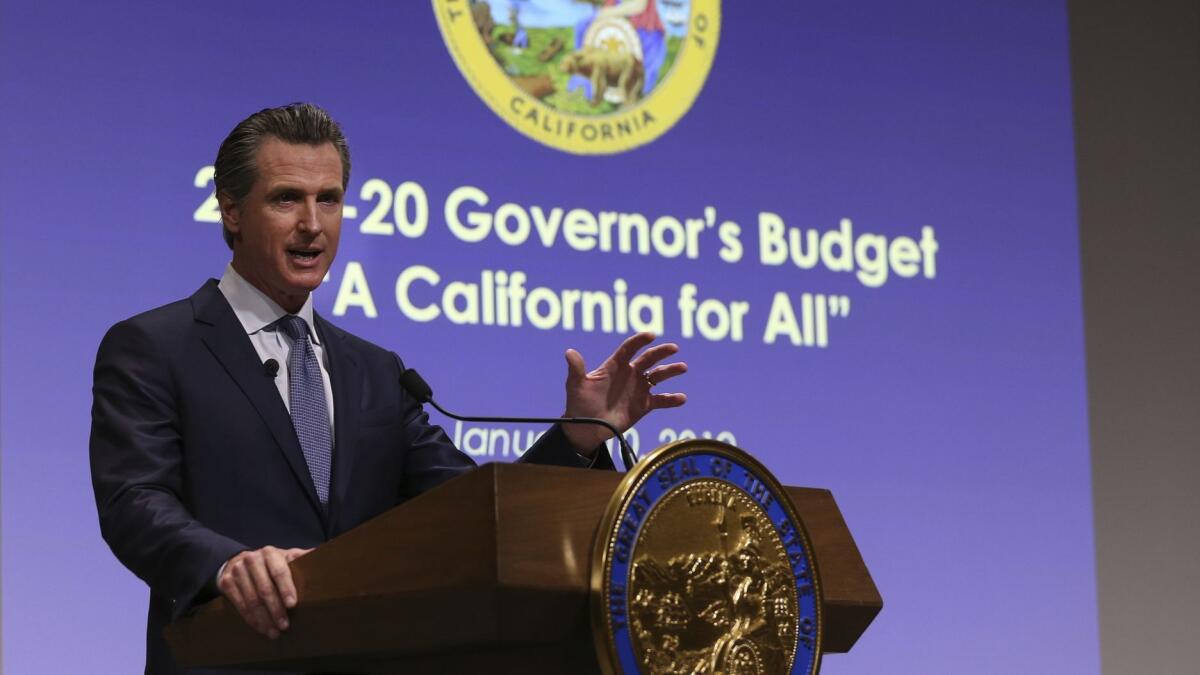Column: Democrats have a lot riding on California’s tax day revenues

- Share via
It’s long been said that two things are key to successfully governing California: ample Sierra Nevada snow to keep the water flowing and plenty of income tax payments to keep state services running. Problems with either can trip up even the most charismatic politician.
The wet and snowy winter took water off the worry list for now. As for income tax revenues, this week will help tell the tale — and there are worries under the state Capitol dome. If April receipts miss the mark, it could mean trouble for the agenda of Gov. Gavin Newsom and the Legislature’s Democratic supermajority.
Newsom’s first budget plan as governor, which was unveiled in January, projected the state will collect $19.9 billion in revenues this month — three-quarters of it from personal income taxes that must be filed by Monday night. Taxpayers who favor installment payments have made January and June important months, too, but April remains a key indicator. The governor will use this month’s revenue collection to revise his spending plan in May, a prelude to legislative approval of a fiscal blueprint in June.
For the April numbers to meet expectations, income tax net receipts of more than $3 billion must be received just on Tuesday — more than $2 million every minute of the day. But that still wouldn’t be enough money to fill the hole left earlier in the year, which means this month’s tally will take on special importance.
Through the end of March, total tax revenues were $2.2 billion below expectations for the fiscal year that ends on June 30. Early data for April suggest revenue is holding steady, perhaps even a little better than expected. But it would take much more cash to bring totals back in line with projections.
Federal tax changes could explain California’s tax revenue shortfall »
So what happened? That’s been one of the big questions in Sacramento over the last few months. Newsom’s budget advisors believe it’s nothing more than delayed tax payments. In February, they argued that Californians who used to pay their income taxes before the new calendar year — and write off those state taxes on their federal taxes — no longer have the incentive to do so under the tax overhaul championed by President Trump. State officials said they assumed the money would show up by the end of April. And so the month of reckoning is here.
If that theory is right, the state’s overall tax revenue picture will be back on track and so will Newsom’s winter prediction of a $21.6-billion discretionary cash reserve. Those dollars are already being counted on to boost a number of programs for needy families and education opportunities for their children. Legislators have been sifting through Newsom’s proposals over the last few weeks while embracing some additional big-ticket ideas — such as funding full access for those in the U.S. illegally to Medi-Cal, the healthcare program for low-income Californians.
But should most or all of the missing money fail to materialize, the governor and Democratic lawmakers will be faced with scaling back some of their ambitious plans now and into the future. After all, it might suggest to budget writers that larger economic forces are at play in disrupting what has otherwise been a solid six-year bonanza of state tax revenues.
Former Gov. Jerry Brown perfected the art of limiting expectations when it came to revenues — and didn’t commit to some key spending plans until long after the tax day dust had settled. Newsom’s approach was to bet big from the beginning; we’ll know in a couple of weeks whether it pays off.
Follow @johnmyers on Twitter and sign up for our daily Essential Politics newsletter
More to Read
Get the L.A. Times Politics newsletter
Deeply reported insights into legislation, politics and policy from Sacramento, Washington and beyond. In your inbox twice per week.
You may occasionally receive promotional content from the Los Angeles Times.











